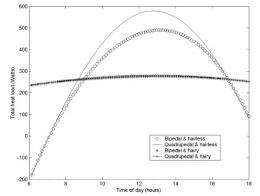December 13, 2011 report
New model suggests early humans lost fur after developing bipedalism

(PhysOrg.com) -- Two of the most basic questions in the study of human evolution revolve around why early people started walking around on two feet instead of four and why they lost their fur, especially in light of the fact that most other primates have kept their coats, and still make extensive use of their hands in walking and especially so, when running. Some have postulated that early hominins began walking upright as a means of helping them keep cooler.
A new model by Graeme Ruxton and David Wilkinson disagrees, writing in their paper published in the Proceedings of National Academy of Sciences, that research they’ve done shows that it was only after early humans began walking upright that they began to lose their fur coats.
Ruxton and Wilkinson don’t offer any new theories as to why early humans started walking upright but they say after studying mathematical models that describe how humans or animals lose body heat based on different postures during different times of the day, that as expected, it appears a crouched posture does conserve body heat more so than does a fully erect one, especially in direct sunlight, suggesting that walking erect would indeed seem to be a way to keep cooler. Unfortunately, they say, that doesn’t take into account the body heat that is created internally by the very act of moving around. Thus, they say, models that suggest humans started walking upright as a means to cool off aren’t looking at the whole picture because in addition to the metabolic heat generated, the cooling effect gained in losing body hair would be much more profound in a person walking upright, than would be the case for one who remained crouching.
Thus, they argue, it was only after hominins started walking upright that they began losing their fur, though they do agree that the latter change came about as a means of keeping cooler.
No one really knows why hominins became bipedal, whether because it helped see threats and food options better, or because it helped them reach up into trees for fruit or whether as previous models suggest it helped in cooling down in the hot African climate, but, regardless, it seems models that seek to explain the change will be forever intricately linked with the reasons that they lost their fur as well.
More information: Avoidance of overheating and selection for both hair loss and bipedality in hominins, PNAS, Published online before print December 12, 2011, doi: 10.1073/pnas.1113915108
Abstract
Two frequently debated aspects of hominin evolution are the development of upright bipedal stance and reduction in body hair. It has long been argued, on the basis of heat-balance models, that thermoregulation might have been important in the evolution of both of these traits. Previous models were based on a stationary individual standing in direct sunlight; here we extend this approach to consider a walking hominin, having argued that walking is more thermally challenging than remaining still. Further, stationary activities may be more compatible with shade seeking than activities (such as foraging) involving travel across the landscape. Our model predictions suggest that upright stance probably evolved for nonthermoregulatory reasons. However, the thermoregulatory explanation for hair loss was supported. Specifically, we postulate progressive hair loss being selected and this allowing individuals to be active in hot, open environments initially around dusk and dawn without overheating. Then, as our ancestors’ hair loss increased and sweating ability improved over evolutionary time, the fraction of the day when they could remain active in such environments extended. Our model suggests that only when hair loss and sweating ability reach near-modern human levels could hominins have been active in the heat of the day in hot, open environments.
Journal information: Proceedings of the National Academy of Sciences
© 2011 PhysOrg.com




















